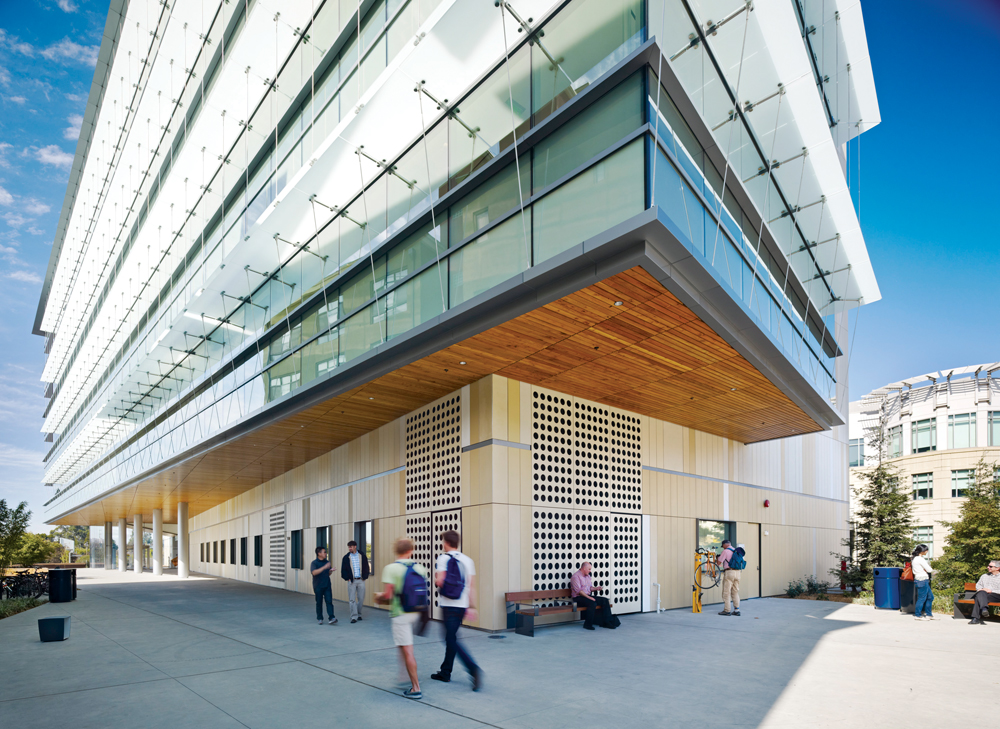After an era of biology-oriented spending—largely driven by Big Pharma and government concerns about bioterrorism—climate change is reshaping priorities in science and technology construction. “Engineering and chemistry funding are going up now, as is energy research, which seems to continue to get federal funding,” says Andy Vazzano, FAIA, LEED AP, Science and Technology Practice Leader at SmithGroupJJR. “Meanwhile, the sequester and budget cuts are having a negative impact on NIH funding for biomedical research.”
The focus on human health hasn’t totally faded, with many research universities still building new labs—especially those that tie research to clinical practice. “Anything that begins with ‘trans’ or ‘inter’ is still a major trend,” says Ryan Abbott, Science and Technology Project Director at Sundt Construction and a BD+C “40 Under 40” honoree (Class of 2012). “Translational, interdisciplinary. Modern science is a team sport.”
TOP S&T SECTOR ARCHITECTURE FIRMS
2012 S+T Revenue ($)1 HDR Architecture $91,252,0002 Perkins+Will $48,373,5683 HOK $38,347,0004 Stantec $33,111,4695 SmithGroupJJR $26,400,0006 Flad Architects $21,480,0007 Payette $18,434,0298 ZGF Architects $16,214,2679 EwingCole $11,000,00010 FKP Architects $10,250,000
TOP S&T SECTOR ENGINEERING FIRMS
2012 S+T Revenue ($)1 Affiliated Engineers $19,824,0002 Middough $13,900,0003 URS Corp. $11,772,1244 Bard, Rao + Athanas Consulting Engineers $10,500,0005 RMF Engineering Design $9,200,0006 Vanderweil Engineers $7,851,9007 Paulus, Sokolowski and Sartor $7,500,0008 WSP USA $5,772,0959 Science Applications International Corp. $3,103,15210 STV $2,937,000
TOP S&T SECTOR CONSTRUCTION FIRMS
2012 S+T Revenue ($)1 Skanska USA $376,717,4742 DPR Construction $298,563,6423 Suffolk Construction $290,560,3074 Manhattan Construction $199,444,0005 Whiting-Turner Contracting Co., The $193,160,4256 JE Dunn Construction $184,799,0517 Clark Group $174,348,8048 Turner Corporation, The $157,490,0009 Structure Tone $143,798,00010 Consigli Construction $74,568,263
Though the purpose-built med school building is the iconic face of S+T, adaptive reuse is getting a second look for advantages in cost and speed. Many clients are also seeking higher levels of green; LEED Platinum, once thought impossible for labs, is no longer unique, and clients are increasingly eyeing net-zero.
In addition, look for public/private partnerships to assume a greater role, even in the rarefied atmosphere of the Ivy League. Harvard, for instance, has rethought its Allston science campus during a recession hiatus. When the site cranks up again next year, the program will include a 36-acre, privately developed “enterprise research campus” for related companies in pharma, biotech, and venture capital.
Read BD+C's full Giants 300 Report
Related Stories
| Sep 16, 2010
Gehry’s Santa Monica Place gets a wave of changes
Omniplan, in association with Jerde Partnership, created an updated design for Santa Monica Place, a shopping mall designed by Frank Gehry in 1980.
| Sep 16, 2010
Green recreation/wellness center targets physical, environmental health
The 151,000-sf recreation and wellness center at California State University’s Sacramento campus, called the WELL (for “wellness, education, leisure, lifestyle”), has a fitness center, café, indoor track, gymnasium, racquetball courts, educational and counseling space, the largest rock climbing wall in the CSU system.
| Sep 13, 2010
Community college police, parking structure targets LEED Platinum
The San Diego Community College District's $1.555 billion construction program continues with groundbreaking for a 6,000-sf police substation and an 828-space, four-story parking structure at San Diego Miramar College.
| Sep 13, 2010
Campus housing fosters community connection
A 600,000-sf complex on the University of Washington's Seattle campus will include four residence halls for 1,650 students and a 100-seat cafe, 8,000-sf grocery store, and conference center with 200-seat auditorium for both student and community use.
| Sep 13, 2010
Second Time Around
A Building Team preserves the historic facade of a Broadway theater en route to creating the first green playhouse on the Great White Way.
| Sep 13, 2010
Palos Community Hospital plans upgrades, expansion
A laboratory, pharmacy, critical care unit, perioperative services, and 192 new patient beds are part of Palos (Ill.) Community Hospital's 617,500-sf expansion and renovation.
| Sep 13, 2010
China's largest single-phase hospital planned for Shanghai
RTKL's Los Angles office is designing the Shanghai Changzheng New Pudong Hospital, which will be the largest new hospital built in China in a single phase.
| Sep 13, 2010
Richmond living/learning complex targets LEED Silver
The 162,000-sf living/learning complex includes a residence hall with 122 units for 459 students with a study center on the ground level and communal and study spaces on each of the residential levels. The project is targeting LEED Silver.















